维基百科:中印公路
中印公路(Ledo Road),又称列多公路、雷多公路、利多公路,是在二战期间,日军切断滇缅公路后修建的,从印度阿萨姆邦雷多镇出发,经缅甸克钦邦密支那抵达中国云南昆明的一条公路。是二战中中国战区的军事供给线,通过这条公路,西方盟军源源不断地给中国提供军事供应。中印公路对维持中国抗战,具有很重要的地位。1945年初,改名为史迪威公路。
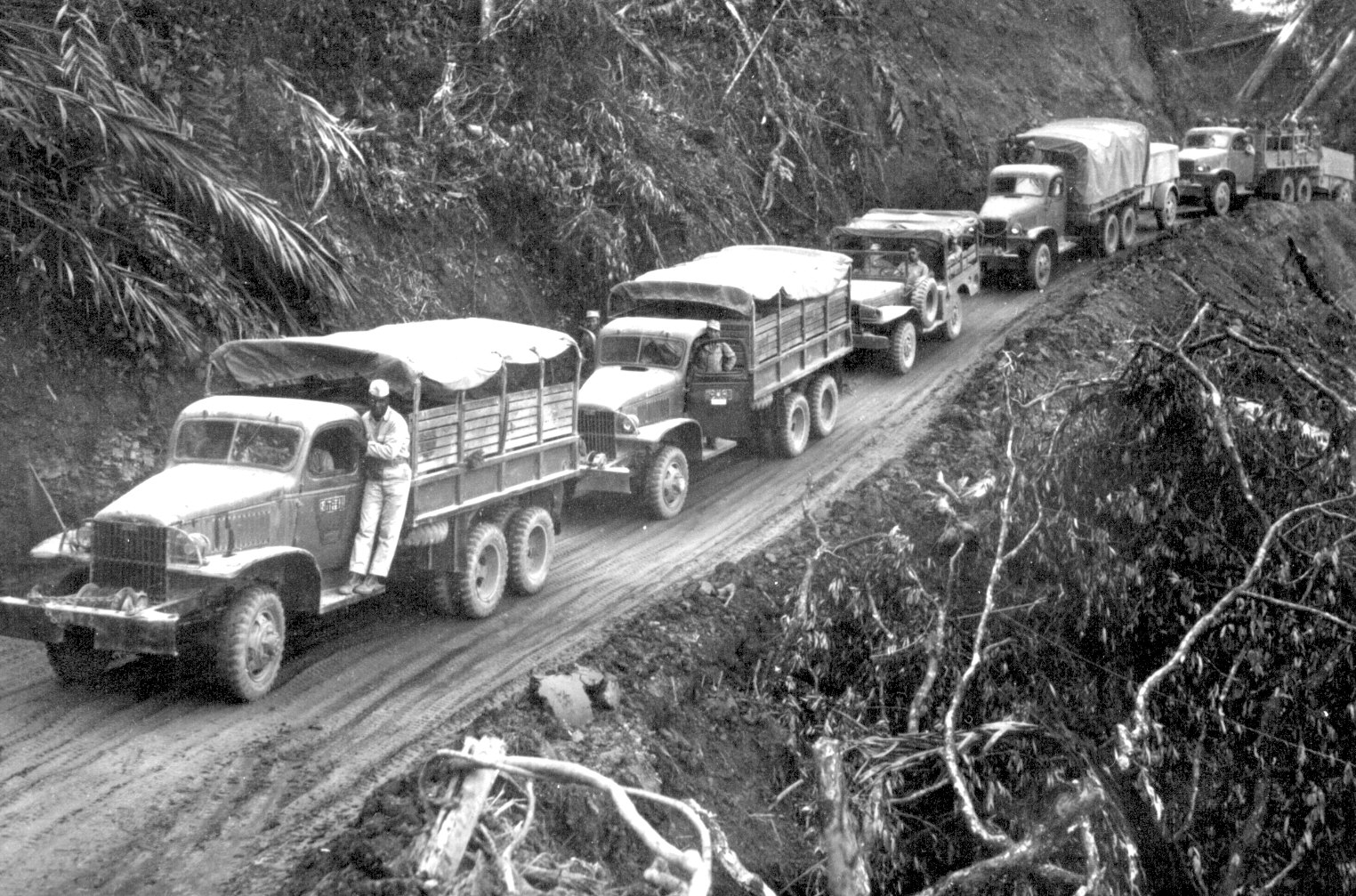
(二战时期在中印公路上行驶的美军卡车)
/** 完整分辨率 (1,524 × 1,007 像素,文件大小:472 KB,MIME类型:image/jpeg)
描述摘要 African-americans-wwii-009.jpg
from NARA :”U.S.-built Army trucks wind along the side of the mountain over the Ledo supply road now open from India into Burma…” n.d. 208-AA-45L-1 Comment: GMC CCKW trucks
来源 NARA — Pictures of World War II **/
公路现况
中印公路在中国境内为320国道,起点在云南昆明,分为1945年建的旧中印公路(即为史迪威公路)及1946年建的新中印公路(腾密公路),旧中印公路前段昆明到缅甸木姐跟滇缅公路共线,后而转往密支那往印度雷多,全长2125公里(中国内为850公里,国外为1275公里)网络上常写的1220公里为缅甸木姐到印度雷多的距离,新中印公路为1946年完工,昆明至保山跟滇缅公路同线,而后由保山转往腾冲直线开往密支那再往印度雷多,又称腾密公路,全长约295公里(中国境内约180公里,境外约115公里)。
里程(旧中印公路)
城市名 距起点距离
云南昆明 0
云南安宁 33
云南楚雄 168
云南南华 204
云南大理 378
云南永平 478
云南保山 579
云南龙陵 721
云南潞西 748
云南畹町市 833
缅甸木姐 905
缅甸八莫 1048
缅甸密支那 1160
缅甸新平洋/新辈洋 1960
印度雷多 2125
约瑟夫·史迪威
维基百科/约瑟夫·华伦·史迪威(Joseph Warren Stilwell,1883年3月19日-1946年10月12日),美国军人,陆军四星上将,曾经在二次大战期间驻中国接近三年,任驻华美军司令,盟军中国战区参谋长。后因与蒋中正关系破裂而离任。
初年
史迪威在佛罗里达州出生,1904年在西点军校毕业。之后曾在菲律宾服役及于西点任教,亦曾于美国最高国防学院,“指挥及参谋学院”就读。第一次世界大战期间赴欧,任第四集团军情报官,获杰出服务勋章。两次大战期间曾驻中国,学习中文;1926年至1929年期间任驻华第十五步兵团营长及参谋(当时之代理团长为马歇尔),1935年至1939年任驻华大使馆军事参赞。
二次大战
1939年─1940年于第二步兵师内任职,1940年─1941年在加州训练第七步兵师。日本偷袭珍珠港后中国向轴心国宣战。美国于1942年委派史迪威赴中国战时首都重庆,任同盟国“中国、缅甸、印度战区”总参谋长(最高司令为蒋介石),兼任驻华美军司令,美国总统特使。史迪威当时的主要任务为确保对中国的物资供应。当时国民政府对外交通为日军封锁,只剩滇缅公路仍然通行。然而日军向英国宣战后迅速攻占新加坡、马来西亚,然后转而攻击缅甸,缅甸形势可危。中国应要求于1942年初派出远征运进入缅甸,由史迪威指挥。由于英军迅速溃退,中国远征军陷入包围。最终入缅之中国远征运一部份跟随史迪威命令撤入印度,另外大部份经原始森林,承受重大损失后返回中国。
缅甸陷落后,中国在陆地及海上运输线被切断,所有运输只能由印度经驼峰由空运进行。史迪威希望能再次打通经缅甸之交通,一雪前耻。史迪威将从缅甸撤到印度的两师中国军队(新38师及新22师)在印度进行训练,并改换美军装备,编成之军队即为“新一军”。另一方面以空运至中国云南之美械装备中国军队二十个师,以及由美军顾问加以训练;预备从两面夹攻收服缅北。
与蒋介石关系
自从史迪威从缅北败退,即开始与蒋介石关系逐渐不和,史迪威曾替蒋介石取了个“Peanut”(没用的小人物、花生米)的绰号,甚至将黄山的蒋介石山庄称为“Berchtesgaden”(希特勒山庄)。1942年初史迪威指挥远征军时,发现原来中国将领仍然受蒋介石直接命令,感到十分不满。首次征缅失败后,蒋介石对再次派兵入缅向日反攻抱迟疑态度。蒋介石认为中国军队训练及装备不足,而美国并无按原来计划数量运输补给予中国;加上英国撤回原定从海上支持进攻的计划,因此认为再次攻缅并无把握,对史迪威再三催促仍未为所动。同时又多番提出要求美国增加援助数量。史迪威则认为蒋介石对抗日消极,贪得无厌,加上其他原因,对其十分轻视。另外史迪威对国民党的无能及腐败深感到厌恶,一度建议美国完全终止援助。另一方面史迪威对共产党却怀有相当好感,认为共产党是真正有能力抗日的力量,而共产主义者不过是土地改革者,曾建议将部份美援给予延安。蒋介石自1943年起曾两次要求美国撤换史迪威,但因为马歇尔在美国的反对而未能成事。
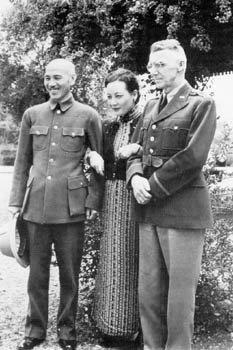
(蒋介石、宋美龄与史迪威)
史迪威公路
1943年中缅印战区划分为中国战区及东南亚战区,蒙巴顿为东南亚战区司令,史迪威为副司令。1943年12月起,史迪威亲自指挥中国驻印军及麦利尔突击队反攻缅北,最终于1944年8月收服缅北交通重镇密支那。而由印度利多,经缅北密支那到中国云南的中印公路亦于1945年1月建成,并被命名为史迪威公路。
被撤回国
史迪威与蒋中正的关系最终发展成势成水火。1944年年春季以后,日军在华发动“一号作战”打通大陆桥,国军在西南、河北大溃败。美国总统罗斯福对中国形势表示忧虑,加上史、蒋二人长期不和,于是特意派出副总统华莱士到中国亲自了解情况。华莱士到华后对国民政府的统治能力给予很低的评价,但同意史迪威成为两国交往的障碍。8月中,罗斯福再三提出蒋中正将中国大陆之军队交予史迪威指挥,为此特意将史迪威晋升为上将。罗斯福一度以接近命令的口吻向蒋提出要求,史迪威得悉后,亲自将该份电报交予蒋介石,之后在他的日记中记下快慰之感。蒋介石回覆罗斯福,倘若要将指挥权交予史迪威,宁愿不惜脱离盟国独自抗日。最终罗斯福权衡下在1944年10月18日下达命令撤换史迪威,其职务由魏德迈接手。
史迪威回国后,先后任美军第十军团司令,及第六军团司令。1946年10月12日现役中因癌症在旧金山病逝。
Ledo Road
From Wikipedia, the free encyclopedia
The Ledo Road, (from Ledo, Arunachal Pradesh, India to Kunming, Yunnan, China) was built during World War II so that the Western Allies could supply the Chinese as an alternative to the Burma Road which had been cut by the Japanese in 1942. It was renamed the Stilwell Road (named after General Vinegar Joe Stilwell of the U.S. Army)) in early 1945 at the suggestion of Chiang Kai-shek. After Rangoon was captured by the Japanese and before the Ledo Road was finished, the majority of supplies to the Chinese were delivered via airlift over the eastern end of the Himalayan Mountains known as the Hump.
In the nineteenth century British railway builders had surveyed the Pangsau Pass, which is 3,727 feet (1,136 meters) high on the India-Burma border, on the Patkai crest, above Nampong, Arunachal Pradesh (then part of Assam). They concluded that a track could be pushed through to Burma and down the Hukawng Valley. Although the proposal was dropped, the British prospected the Patkai Range for a road from Assam into northern Burma. British engineers had surveyed the route for a road for the first eighty miles. After the British had been pushed back out of most of Burma by the Japanese, building this road became a priority for the United States.
Building the Ledo Road
On the December 1, 1942, British General Sir Archibald Wavell, the supreme commander of the Far Eastern Theatre, agreed with American General Stilwell to make the Ledo Road an American NCAC operation. The Ledo Road was intended to be the primary supply route to China, and was built under the direction of General Stilwell from the railhead at Ledo (Assam, India)[1] to Bhamo on the Burma Road so that supplies could reach the railhead at Mogaung. Stilwell’s staff estimated that the Ledo Road route would supply 65,000 tons of supplies per month, greatly surpassing tonnage then being airlifted over the Hump to China.[2] General Claire Lee Chennault, the USAAF Fourteenth Air Force commander, thought the projected tonnage levels were overly optimistic, and doubted that such an extended network of trails through difficult jungle could ever match the amount of supplies that could be delivered with modern cargo transport aircraft.[3]
The road was built by 15,000 American soldiers (60% of whom were African-Americans) and 35,000 local workers at a cost of US$150 Million. 1,100 Americans died during the construction, as well as many more locals.[4] As most of Burma was in Japanese hands it was not possible to acquire information as to the topography, soils, and river behaviour before construction started. This information had to be acquired as the road was constructed.
General Stilwell had organized a ‘Service of Supply’ (SOS) under the command of Major General Raymond A. Wheeler, a high profile US Army Engineer and assigned him to look after the construction of the Ledo Road. Major General Wheeler in turn, assigned responsibility of base commander for the road construction to Colonel John C. Arrowsmith. Later, he was replaced by Colonel Lewis A. Pick, an expert US Army engineer.
Work started on the first 103 mile (166 km) section of the road in December 1942, followed a steep, narrow trail through territory from Ledo, across the Patkai Range through the Pangsau Pass, nicknamed “Hell Pass” for its difficulty, and down to Shingbwiyang, Burma. Sometimes rising as high as 4,500 feet (1400 m), the road required the removal of earth at the rate of 100,000 cubic feet per mile (1800 m³/km). Steep gradients, hairpin curves and sheer drops of 200 feet (60 m), all surrounded by a thick rain forest was the norm for this first section. The first bulldozer reached Shingbwiyang on 27 December 1943, three days ahead of schedule.
The building of this section allowed much-needed supplies to flow to the troops engaged in attacking the Japanese 18th Division, which was defending the Northern area of Burma with their strongest forces around the towns of Kamaing, Mogaung and Myitkyina. Before the Ledo road reached Shingbwiyang, Allied troops (the majority of whom were American-trained Chinese Divisions of the X Force) had been totally dependent on supplies flown in over the Patkai Range. As the Japanese were forced to retreat south so the Ledo road was extended. This was made considerably easier from Shingbwiyang by the presence of a fair weather road built by the Japanese, and the Ledo road generally followed the Japanese trace. As the road was built, two 10 cm (4 inch) fuel pipe lines were laid side by side so that fuel for the supply vehicles could be piped instead of trucked along the road.
After the initial section to Shingbwiyang, more sections followed: Warazup, Myitkyina and Bhamo, 372 miles (600 km) from Ledo. At that point the road joined a spur of the old Burma road and although improvements to further sections followed the road was passable. The spur passed through Namkham 439 miles (558 km) from Ledo and finally at the Mong-Yu road junction, 465 miles (748 km) from Ledo, the Ledo road met the Burma road. To get to the Mong-Yu junction the Ledo road had to span 10 major rivers and 155 secondary streams, averaging one bridge every 2.8 miles (4.5 km). For the first convoys, if they turned right, they were on their way to Lashio 100 miles (160 km) to the South through Japanese-occupied Burma, if they turned left Wanting lay 60 miles (100 km) to the North just over the China-Burma border. However, by late 1944, the road still did not reach China; by this time, tonnage airlifted over the Hump to China had significantly expanded with the arrival of more modern transport aircraft.
In late 1944, barely two years after Stilwell accepted responsibility for building the Ledo Road, it connected to the Burma Road though some sections of the road beyond Myitkyina at Hukawng Valley were under repair due to heavy monsoon rains, and it became a highway stretching from Assam, India to Kunming, China 1,079 miles (1736 km) length. On January 12, 1945, the first convoy of 113 vehicles, led by General Pick, departed from Ledo; they reached Kunming, China on February 4, 1945. In the six months following its opening, trucks carried 129,000 tons of supplies from India to China.[5] Twenty-six thousand trucks that carried the cargo (one-way) were handed over to the Chinese.[5] However, as General Chennault had predicted, supplies carried over the Ledo Road at no time approached tonnage levels of supplies airlifted monthly into China via the Hump.[6] In the month of July 1945, the last full month before the end of the war, 71,000 tons of supplies were flown over the Hump, compared to only 6,000 tons using the Ledo Road; the airlift operation continued in operation until the end of the war, with a total tonnage of 650,000 tons compared to 147,00 for the Ledo Road.[6][3] By the time supplies were flowing over the Ledo Road in large quantities, operations in other theaters had shaped the course of the war against Japan.[2]
There was a mile sign at the start of the Ledo Road with the following information[7][8]
Ledo Assam 0
Shingbwiyang 103
Warazup 189
Myitkyina 268
Bhamo 372
Wanting 507
Lunfling 560
Paoshan 652
Yungping 755
Yunnanyi 876
Tsuyung 959
Kunming 1079
When flying over the Hukawng Valley during the monsoon, Mountbatten asked his staff what was the name of the river below them. An American officer replied, “That’s not a river, it’s the Ledo Road.”[9]
American Army units assigned to the Ledo Road
The units initially assigned to the initial section were:[10]
45th Engineer General Service Regiment (An African-American Unit)
823rd Aviation Engineer Battalion (EAB) (An African-American Unit)
In 1943 they were joined by:
848th EAB (An African-American Unit)
849th EAB (An African-American Unit)
858th EAB (An African-American Unit)
1883rd EAB (An African-American Unit)
Work continued through 1944 in late December it was opened for the transport of logistics. In January 1945, four of the black EABs (along with three white battalions) continued working on the now renamed Stilwell Road, improving and widening it.
Views on the construction the road
Winston Churchill called the project “an immense, laborious task, unlikely to be finished until the need for it has passed”.
The British Field Marshal William Slim who commanded the British Fourteenth Army in India/Burma wrote of the Ledo Road:
I agreed with Stilwell that the road could be built. I believed that, properly equipped and efficiently led, Chinese troops could defeat Japanese if, as would be the case with his Ledo force, they had a considerable numerical superiority. On the engineering side I had no doubts. We had built roads over country as difficult, with much less technical equipment than the Americans would have. My British engineers, who had surveyed the trace for the road for the first eighty miles [130 km], were quite confident about that. We were already, on the Central front, maintaining great labour forces over equally gimcrack lines of communication. Thus far Stilwell and I were in complete agreement, but I did not hold two articles of his faith. I doubted the overwhelming war-winning value of this road, and, in any case, I believed it was starting from the wrong place. The American amphibious strategy in the Pacific, of hopping from island to island would, I was sure, bring much quicker results than an overland advance across Asia with a Chinese army yet to be formed. In any case, if the road was to be really effective, its feeder railway should start from Rangoon, not Calcutta.
—William Slim.[11]
Post World War II
After Burma was liberated, the road fell into gradual disrepair. The last recorded vehicular journey from Ledo to Myitkyina and beyond (but not to China) was the Oxford-Cambridge Overland Expedition which in 1955 drove from London to Singapore and back. For many years, travel into the region was highly restricted because of an active insurgency against the Government of India. Because of continuous clashes between insurgents (which were seeking shelter in Burma) and the Indian Armed Forces, India imposed harsh restrictions between 1962 and the mid 1990s on travel into Burma which also applied to all outsiders.
More recent attempts to travel the road have met with different results. The expedition book written by Tim Slessor reported that bridges were down in the section between Pangsau Pass and Shingbwiyang. At present the Nampong-Pangsau Pass section is passable in 4WD vehicles. The road on the Burmese side is reportedly fit for vehicular traffic. Donovan Webster reached Shingbwiyang on wheels in 2001, and in mid-2005 veterans of the Burma Star Association were invited to join a ‘down memory lane’ trip to Shingbwiyang organised by a politically well connected travel agent. None of these groups which successfully travelled the road made any comment on the political or human rights situation on Burma afterward. Burmese from Pangsau village saunter nonchalantly across Pangsau Pass down to Nampong in India for marketing, for the border is open despite the presence of insurgents on both sides. There are Assam Rifles and Burma Army posts at Nampong and Pangsau respectively. But the rules for locals in these border areas do not necessarily apply to westerners. The governments of both countries keep careful watch on the presence of westerners in the border areas and the land border is officially closed. Those who cross without permission risk arrest or problems with smugglers/insurgents in the area.
Reconstruction in Modern Burma
In recent years, the Burmese government has focused on the reconstruction of the Ledo Road as an alternative to the existing Lashio-Kunming Burma Road. The Chinese government completed construction of the Myitkyina-Kambaiti section in 2007 and the Rangoon based Yuzana company is constructing the section between Myitkyina and Tanai.[12][13]
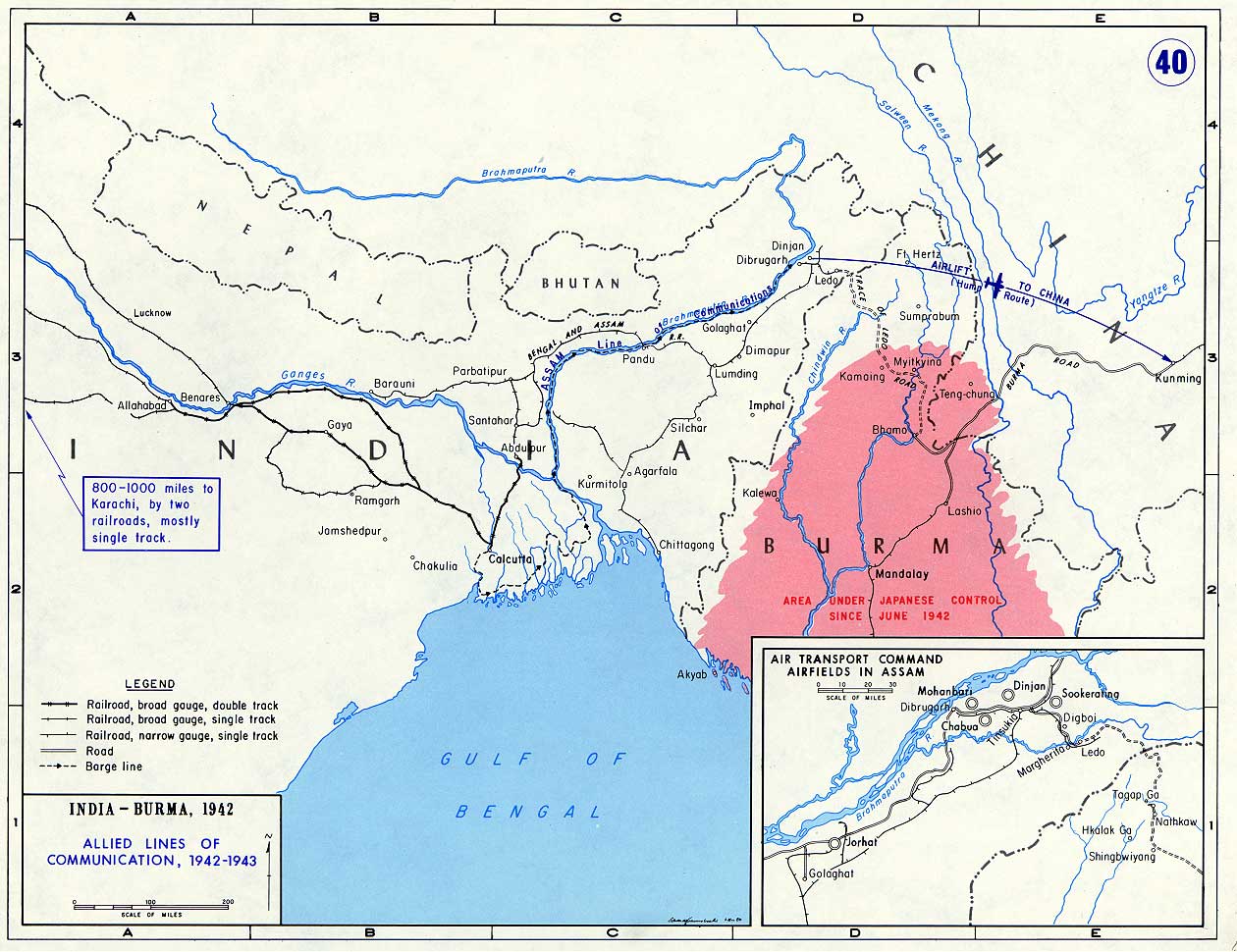
Allied lines of communication in Southeast Asia (1942–43). The Ledo Road is shown at far right.
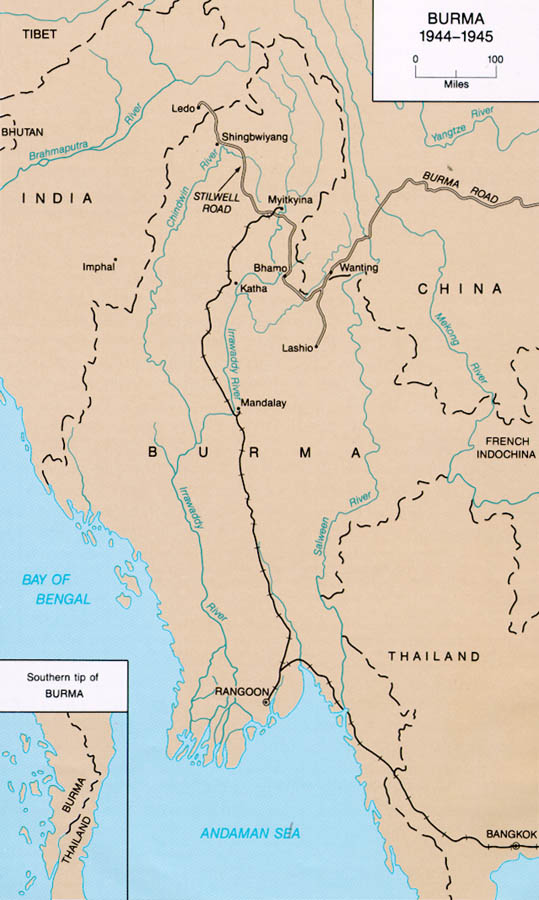
Burma Road and Ledo Road in 1944

A U.S. Army soldier and a Chinese soldier place the flag of their ally on the front of their jeep just before the first truck convoy in almost three years crossed the China border en route from Ledo, India, to Kunming, China, over the Stilwell road in 1945
http://en.wikipedia.org/wiki/Ledo_Road
STILWELL ROAD
The historic Stilwell’s Road, which was constructed by the Americans during the Second World War from Ledo in Assam, India, which is one of the rail-heads of the Bengal-Assam railway in the valley of the Upper Brahmaputra during that time to Burma Road connecting to Kunming, China passes through Lekhapani, Jairampur, Nampong and Pangsau pass, India-Burma (Myanmar) border. It winds up the passes of 9000 feet Patkai Range and emerges at Shindbwiyang and then Myitkyina. It crosses the broad bowl of the Upper Chindwin, threads the Hukawng and Mogaung valleys, and goes down to Bhamo and to the Burma road which connects Kunming, Yunnan province, China.
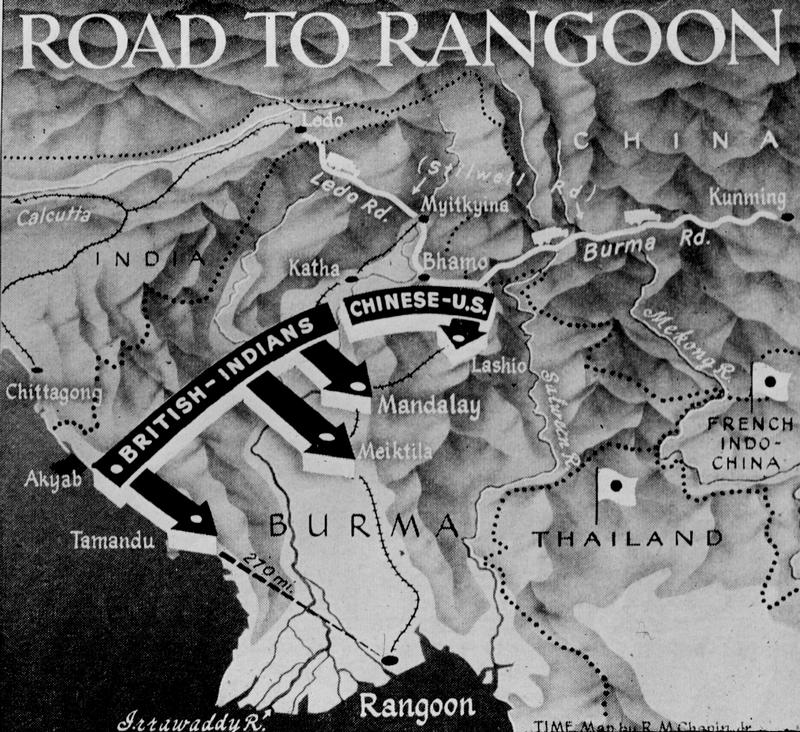
World War II map of Stilwell Road, China-Burma-India front
Originally it was called ‘Ledo Road’; later it was name after the General Joseph Warren Stilwell (1883-1946), Chief of Staff to Allied Forces in China-Burma-India theatre for defence of Burma (Myanmar) from Japanese forces under the Generalissimo, Marshal Chiang Kai-shek, Supreme Command of the forces of the United Nations in China, including such parts of Indo-China and Siam as might become accessible to the troops.
The Ledo road (Stilwell’s Road) was constructed under his direct supervision during the war. He had also participated in the First World war and mastered the Chinese language during his stay at Philippines and China after the War. He was better known to the World as “Vinegar Joe”, though his troops called him “Uncle Joe”.
Initially, this project was prospected by British long before the Second World War and could not implemented until the agreement between the British and Joseph W. Stilwell representing Americans on December 1, 1942 during the Second World War when Burma was fully under Seized by the Japanese forces.
Allied Forces extremely in need of this road for restoration of line of communication between China and Burma, and a line of communication to Allied forces in Burma from India to liberate Burma from the claws of Japanese forces as the topography of the Indo-Burma border was very difficult terrains with thick, inaccessible and malaria and Dysentery infested forests. General Stilwell’s Operations Officer, Lieutenant Colonel Frank D. Merrill recommended building a road from Ledo, Assam, India to Burma connecting the old Burma Road to provide a Land Supply to China and Burma for support of the Allied soldiers who were fighting in the North Burma.
Lieutenant Colonel Frank D. Merrill Commanding officer of “the experienced jungle troops, for a dangerous and hazardous Mission – somewhere” lead his specially trained 5307 Composite Unit (Provisional) called “Merrill’s Marauders”, code named “Galahad” to the Ledo Road and started marching on foot from Margherita, near Ledo, India on February 7, 1944 passing through Pangsau Pass (Hell Pass), Shindbwiyang, Jambu-Bam, and then Myitkyina most of the times fighting and struggling against rains, mud, swamps, Malaria, Dysentery, Typhoid and strategically positioned enemies at different locations on their way. Merrill’s Marauders seized Myitkyina air-strip on May 17, 1944 despite strong resistance from Japanese forces. Then after some days later, they captured Myitkyina town itself, which was stronghold of Japanese forces based in north Burma and the two months campaign ended on August 3, 1944 with Merrill’s Marauders 127 deaths and 291 wounded besides, other casualties. Myitkyina was one of the main missions of Stilwell.
In December 1942, the road construction begun by constructing Warehouses, Hospitals, Barracks and base roads at Ledo, Assam, India side by side fighting with the Japanese forces. On December 16, 1942, Americans began building the double-track, all-weather Ledo road. Subsequently, the Americans had brought heavy road construction machineries to these wild hills like Bulldozers, Cranes, Power-shovels, Caterpillars, Steam-rollers, in massive procession from the United State production-lines 12,000 miles away, across two Oceans and past three Continents.
General Stilwell had organized a ‘Service of Supply’ (SOS) under the command of Major General Raymond A. Wheeler, a high profile US Army Engineer and assigned him to look after the construction of the Ledo road. Major General Wheeler in turn, assigned responsibility of base commander for the road construction to Colonel John C. Arrowsmith. Later, he was replaced by Colonel Lewis A. Pick, an expert US Army engineer, as road construction was slowed down under Arrowsmith during the monsoon season of 1943. He had employed some of the finest mechanical roadmakers from Americans, British, Indian, Chinese and West Africans to fight against the wild jungles, tangles of swamp and forest, deep valleys and high cliffs and test of heavy rains and floods across the Indo-Burma mountain Range.
On December 27, 1943, three days ahead of schedule, the road reached Shindbwiyang Finished grading and graveling remained to be done, but the 117 miles from Ledo to Shindbwiyang were open before January 1, 1944, as General Stilwell wished. Colonel Pick’s celebration for the engineers omitted none of the available essentials. As he congratulated them for opening 54 miles of trace in 57 days, a convoy came rolling into Shindbwiyang with candy, doughnuts, and 9,600 cans of beer.
In late 1944, barely two years after Stilwell accepted responsibility for building the Ledo Road (Stilwell Road), it connect to the Burma Road though some sections of the road beyond Myitkyina at Hukawng Valley were under repairing due to heavy monsoon water, and it become a highway stretching from Assam, India to Kunming, China 1,079 miles length. On January 12, 1945, the first convoy of 113 vehicles was led by General Pick from Ledo and was reached Kunming, China on February 4, 1945 and celebrated the achievement. The road construction was estimated to cost 137,000,000 dollars.
Two 4-inch fuel pipe lines were laid side by side and followed along the Ledo road from Tinsukia, Assam, India to relieve the road and air traffics of carrying fuel from Assam, India to China. They were fed by gasoline pumped from Calcutta to a station near their starting point.
On May 20, 1945, newly promoted Major General Lewis A. Pick formally announced the completion of the Ledo road, a task he called toughest job ever given to US Army Engineers in Wartime. The road was renamed the Stilwell Road in honour of General Joseph Warren Stilwell at the suggestion of Chiang Kai-shek, it was known to the Engineers who built it as “Pick’s Pike.”
Major General Lewis A. Pick, US Army Engineer who built the Stilwell Road
In the course of time, the Stilwell Road had virtually disappeared due to the road lies in the lands of three different nation that are China, Burma and India and due to non maintenance by the respective nations. However, 61 km of the road lies in India, 1,033 km in Burma (Myanmar) and 632 km in China. In India out of 61 km, 30 km lies in Assam and 31 km in Arunachal Pradesh. The border between Assam and Arunachal Pradesh has 14 km of the road section which is in deplorable condition. The section of road which lies within Arunachal Pradesh has been maintained by the Government of Arunachal Pradesh and the road section which lies within the area of Assam out of 14 km is in deplorable condition due to non maintenance by Government of Assam and vehicular are facing lot of difficulties.
Recently it is reported that the Indian government has proposed this road for reopening as International Highway linking to Myanmar (Burma). Everyone in this area is looking forward for implementation of the project within the stipulated time. Hope this project be implemented in time.
Table showing location-wise distance from Ledo, Assam, India to Kunming, Yunnan, China within the Ledo Road (Stilwell Road):
STILWELL ROAD (LEDO ROAD)
LOCATION Distance from Ledo, Assam, India
in Km in Mile
Ledo 0 0
Pangsau Pass 61 38
Tagap-Ga 127 79
Shindbwiyang 165 103
Jambu-Bum 287 178
Warazup 304 189
Myitkyina 403 250
Bhamo 595 372
Namkham 707 439
Mong-Yu (Ledo-Burma Roads junction) 749 465
Wanting* 811 507
Lungling* 896 560
Paoshan* 1,043 652
Yungpin* 1,208 755
Yunnanyi* 1,402 876
Tsuyung* 1,543 959
Kunming* 1,726 1,079
LENGTH OF ROAD LIES WITHIN
INDIA 61 38
MYANMAR (BURMA) 1,033 646
CHINA 632 395
* Lies on the Burma Road.




